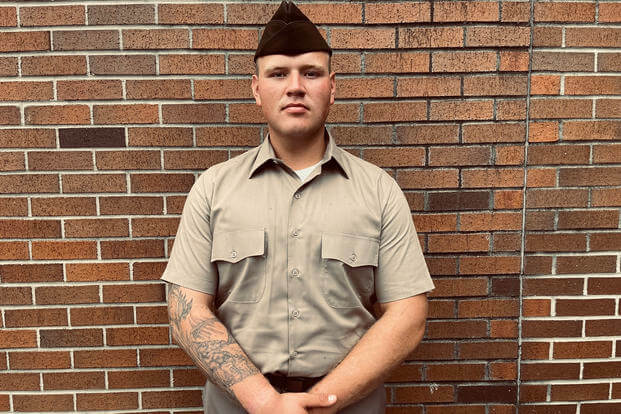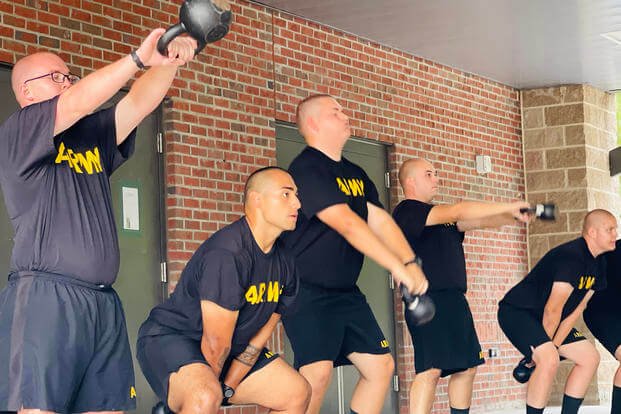FORT JACKSON, South Carolina -- Pvt. David Dean weighed 320 lbs. when he went to visit a National Guard recruiter. A West Virginia plumber by trade, he wanted to prove to himself that he could serve, and he'd always wanted to put on the uniform.
"I could never get in because I was overweight," Dean said.
He visited the recruiter to see just how much he needed to shave off to be eligible to serve and the kind of workouts the Army demands.
Read Next: Unattended Explosives Found at Camp Pendleton Triggered Evacuation, Marine Corps Says
To his surprise, the recruiter was able to get him into the ranks, but with a catch. Dean would have to go to the Army's new Future Soldier Preparatory Course at Fort Jackson, South Carolina. There, new recruits have 90 days to lose enough weight to meet the Army standard and be shipped off to basic training. If not, they are separated from the service and sent home.

Dean lost enough weight at the program to progress into basic training, where he lost the rest over the course of 10 weeks. On Wednesday, Dean graduated from basic training and was honored as the top soldier of his class.
He now weighs 250 lbs. and scored a 570 on the Army Combat Fitness Test, or ACFT, out of 600. That score is far above the average and demonstrates that Dean can deadlift heavy weight, run fast and hold a plank for an impressive amount of time.
"I'm feeling proud, feeling humble," he told Military.com at his graduation. "If you were to ask me two or three years ago if I'd be standing where I'm standing today, I'd say 'absolutely not."
Dean is one of 278 soldiers in his basic training class of 989 new soldiers who attended the prep course. That new program has been a key tool the Army has used for the past year to try to overcome the service's ongoing recruiting slump, which officials largely attribute to a shrinking pool of young Americans eligible to serve, mostly due to obesity and poor academic ability.
Two Tracks
The program has two tracks, one for shedding body fat and another for recruits who came up short on academic standards, performing poorly on the Armed Services Vocational Aptitude Battery, or ASVAB.
Last year, the service ended up 15,000 new soldiers short of its goal of bringing in 60,000 recruits. The Army is expected to fail to hit its more ambitious recruiting goal of 65,000 new soldiers this year.
Instead of lowering standards to fill in the ranks, the Army sought to bring promising recruits up to those standards with the new programs, a sort of pre-boot camp that leaders see as a valuable investment to find Americans capable, but not ready, for service.
For the fitness track, applicants can enlist with up to 6% more body fat than the Army permits. For men, that limit is between 20% and 26% body fat, depending on age. For women, it's between 30% and 36%. Recruits can move onto basic training with body fat 2% above the regulation, with the assumption they will lose it before graduation.
Across both the academic and fitness tracks, at least 10,260 soldiers have graduated and were allowed to attend basic training in the past year. Those are soldiers who otherwise would not have been able to enlist, with the program becoming what top service officials including Army Secretary Christine Wormuth view as a major success.
The Army recently made the decision to graduate the Future Soldier Preparatory Course from a pilot program to fully fledged school cemented into its portfolio, signaling the service will rely on it to fill the ranks for years to come. What won't be known for years is whether those who graduate from the prep courses are able to have long, successful careers at the same rates as their peers who aren't required to attend before boot camp.
One issue that the Army is trying to fight is the tendency for most Americans to put back on weight they've lost. Upward of 80% of those who lose significant weight regain a large proportion of it within a year, according to researchers. That means the Army has to create habits that will help recruits maintain the fitness they've worked hard to attain during the crash course.
Recruits at the fitness prep course lose 1.5% body fat each week, but drill sergeants will intervene if they lose 3% or more per week to see whether the soldier is participating in any unhealthy weight loss tactics.
Soldiers conduct physical training up to three times per day, usually with a main session in the morning and less demanding sessions later that can involve light kettlebell work, stretching or yoga, explained Capt. Emily Rice, commander of the fitness track at Fort Jackson. While no ACFT is conducted during the course, soldiers are familiarized with its events where the priority is proper form and technique.
But that physical training is done with careful precision. Trainees aren't running endless miles in the heat being screamed at by a drill sergeant. They are slowly introduced to running to avoid injury, often starting off with walking for five minutes and running for one minute, alternating for a total of 30 minutes.
"We focus on a lot of active recovery such as foam rolling," Rice, a registered dietitian, told Military.com. "Our PT is programmed so we aren't overtraining,"
The fitness track isn't just about physical training. Recruits also attend classes on nutrition and proper sleep habits -- with one of the priorities imploring that fitness is more than just weightlifting and running.
"I know I did my job well when soldiers in our exit survey say that carbs are not bad," Rice said.
Not a New Concept
Prep courses as a concept aren't new to the force, as the service has a long history of creating programs to bring soldiers up to the Army's standard. For example, there are pre-Ranger courses, to get soldiers prepared for the elite infantry school. There are also programs to set soldiers up for success for Special Forces Assessment and Selection, including in the National Guard, in which soldiers are brought up to snuff on critical skills and physical fitness. There have also been pre-basic training courses in the past for weight loss, but never before have such resources been poured into a program for so many soldiers.
Troops at the prep course come from all walks of life. They range from being fresh high school graduates to recruits in their later twenties who want to change careers.
Joseph Gutierrez, 28, enlisted weighing 332 lbs. He spent two months in the prep course and was able to enter basic training weighing 261 lbs., then lost an additional 40 lbs.
He now weighs 224 lbs. after finishing basic training and scored a 537 on the ACFT.
"I want to stop being lazy," Gutierrez told Military.com. "I had an office job. I wanted to join since I was a child, but I was always too overweight. The most challenging part was changing the lifestyle, eating right and having the right mindset."
Obesity has been considered an epidemic in the United States since 1976, according to the Centers for Disease Control and Prevention. In the late 1970s, the obesity rate among American adults was around 15% and rose to 42% by 2020, and roughly one-quarter of teens were also obese.
Childhood obesity has been attributed to a number of factors, including parents keeping unhealthy foods, such as sugary cereal, orange juice, soda and snacks, too plentiful in the home. Those foods are often heavily marketed, cheap and can be less time-consuming to prepare, a particular struggle for families with parents working multiple jobs.
Some public schools have also gotten rid of gym class in recent decades, and organized sports are too expensive for many families.
Meanwhile, the Army has boosted the physical demands of service with the ACFT. The test includes deadlifts; hand-release push-ups; a timed two-mile run; a plank; an event during which soldiers have to switch between sprinting, carrying 40-lb. kettlebells and dragging a 90-lb. sled; and an event during which the soldier throws a 10-lb. medicine ball as far as they can.
The old fitness test, which started being phased out in 2019, measured only running, sit-ups and regular push-ups.
"It's more demanding," Sgt. 1st Class Stepney Srey, who was recognized as this year's top active-duty drill sergeant with Fort Jackson's Drill Sergeant Academy, told Military.com. "Physical training is different now. There's more technique, and the challenge is to have soldiers progress while also keeping the environment safe."
-- Steve Beynon can be reached at Steve.Beynon@military.com. Follow him on Twitter @StevenBeynon.













